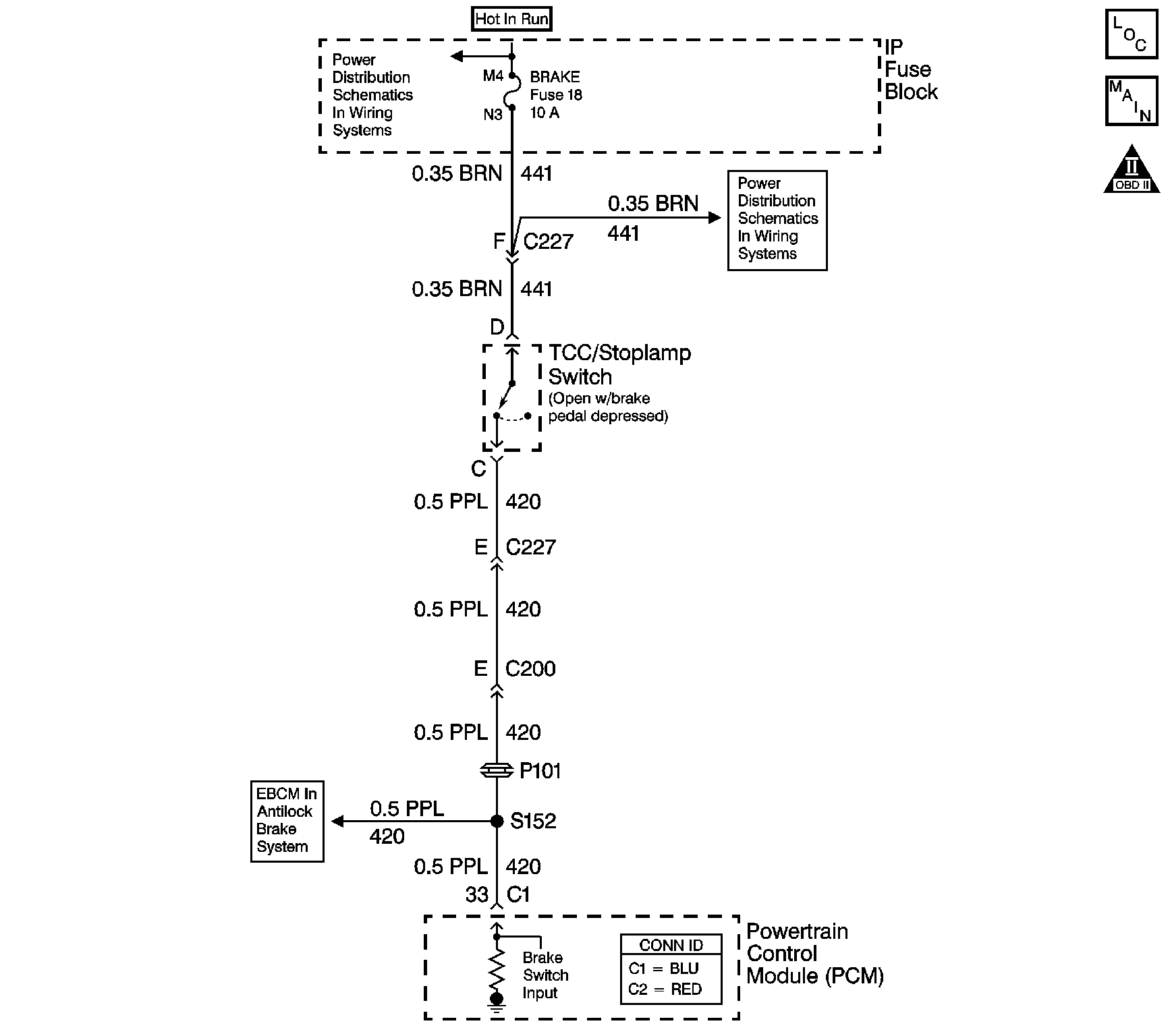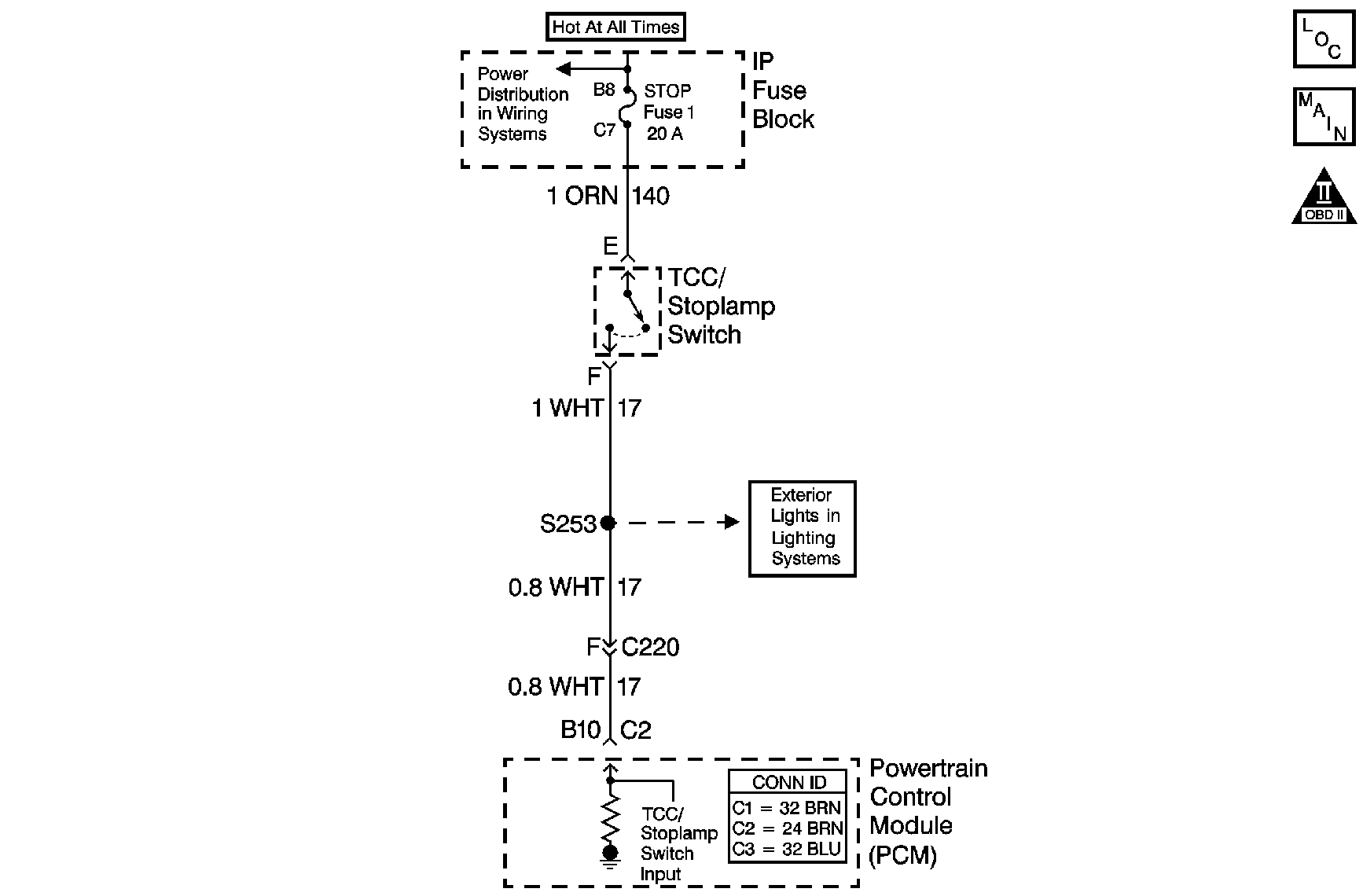DTC P0719 Gas

Circuit Description
The TCC/Stoplamp switch indicates the brake pedal status. The normally-closed TCC/Stoplamp switch supplies a B+ signal to the powertrain control module (PCM). The signal voltage circuit opens when the brakes are applied.
If the PCM detects an open TCC/Stoplamp switch circuit during accelerations, then DTC P0719 sets. DTC P0719 is a type C DTC.
Conditions for Running the DTC
| • | No OSS DTC P0502 or DTC P0503. |
| • | The following sequence of events occurs: |
| 1. | The vehicle speed is less than 8 km/h (5 mph). |
| 2. | Then the vehicle speed is 8-40 km/h (5-25 mph) for 1.7 seconds. |
| 3. | Then the vehicle speed is greater than 40 km/h (25 mph) for 7 seconds. |
Conditions for Setting the DTC
| • | All conditions are met for 8 occurrences. |
| • | The PCM detects an open TCC/Stoplamp switch/circuit (0 volts) for 15 minutes. |
Action Taken When the DTC Sets
| • | The PCM does not illuminate the malfunction indicator lamp (MIL). |
| • | For TCC scheduling, the PCM disregards the brake switch state if the TP sensor is greater than 1.5% and the vehicle speed is greater than 32 km/h (20 mph). |
| • | The PCM records the operating conditions when the Conditions for Setting the DTC are met. The PCM stores this information as Failure Records. |
| • | The PCM stores DTC P0719 in PCM history. |
Conditions for Clearing the DTC
| • | A scan tool clears the DTC from PCM history. |
| • | The PCM clears the DTC from PCM history if the vehicle completes 40 warm-up cycles without a non-emission related diagnostic fault occurring. |
| • | The PCM cancels the DTC default actions when the fault no longer exists and the ignition switch is OFF long enough in order to power down the PCM. |
Diagnostic Aids
Inspect the brake switch for proper mounting and operation.
Test Description
The numbers below refer to the step numbers on the diagnostic table.
-
This step tests for TCC/Stoplamp switch voltage to the PCM connector.
-
This step isolates the TCC/Stoplamp switch as a source for setting the DTC.
-
This step tests for a short to ground in the ignition 3 voltage circuit (CKT 441) (ignition voltage) to the TCC/Stoplamp switch.
-
This step tests for a short to ground in the TCC brake switch signal circuit (CKT 420), from the TCC/Stoplamp switch to the PCM.
-
This step isolates the PCM as a source for causing the fuse to open.
Step | Action | Value(s) | Yes | No | ||||||
|---|---|---|---|---|---|---|---|---|---|---|
1 | Did you perform the Powertrain Diagnostic System Check? | -- | Go to Diagnostic System Check - Engine Controls in Engine Controls | |||||||
2 |
Important: Before clearing the DTCs, use the scan tool in order to record the Failure Records. Using the Clear Info function erases the Failure Records from the PCM. Does the Scan Tool TCC/Stoplamp Switch indicate CLOSED, when the brake pedal is not applied? | -- | Go to Intermittent Conditions in Engine Controls | |||||||
3 |
Refer to General Electrical Diagnosis in Wiring Systems. Is the fuse open? | -- | ||||||||
Does the test lamp illuminate? | -- | |||||||||
5 |
Does the voltage measure within the specified value? | 10-13 V | ||||||||
6 |
Important: The condition that affects this circuit may exist in other connecting branches of the circuit. Refer to Power Distribution Schematics in Wiring Systems for complete circuit distribution. Test the ignition 3 voltage circuit (CKT 441) for an open. Did you find and correct the condition? | -- | -- | |||||||
Does the test lamp illuminate? | -- | |||||||||
8 |
Important: The condition that affects this circuit may exist in other connecting branches of the circuit. Refer to Power Distribution Schematics in Wiring Systems for complete circuit distribution. Test the TCC brake switch signal circuit (CKT 420) for an open. Did you find and correct the condition? | -- | -- | |||||||
9 | Replace the TCC/Stoplamp switch. Refer to Stop Lamp Switch Replacement in Hydraulic Brakes. Did you complete the replacement? | -- | -- | |||||||
Does the fuse open with the brake pedal applied? | -- | |||||||||
11 |
Important: The condition that affects this circuit may exist in other connecting branches of the circuit. Refer to Power Distribution Schematics in Wiring Systems for complete circuit distribution. Test the ignition 3 voltage circuit (CKT 441) for a short to ground. Did you find and correct the condition? | -- | -- | |||||||
With the key in the RUN position, release the brake pedal. Does the fuse open when the brake pedal is released? | -- | Go to Intermittent Conditions in Engine Controls | ||||||||
Does the fuse open? | -- | |||||||||
14 |
Important: The condition that affects this circuit may exist in other connecting branches of the circuit. Refer to Power Distribution Schematics in Wiring Systems for complete circuit distribution. Test the TCC brake switch signal circuit (CKT 420) for a short to ground. Did you find and correct the condition? | -- | -- | |||||||
15 | Replace the PCM. Refer to Powertrain Control Module Replacement in Engine Controls. Did you complete the replacement? | -- | -- | |||||||
16 | Perform the following procedure in order to verify the repair:
Does the TCC Brake Switch indicate CLOSED when the brake pedal is not applied, then indicate OPEN when the brake pedal is applied? | -- | System OK |
DTC P0719 Diesel

Circuit Description
The normally open TCC/Stoplamp switch indicates brake pedal status to the powertrain control module (PCM). Applying the brake pedal closes the switch, supplying voltage to the PCM. Releasing the brake pedal interrupts voltage to the PCM.
If the PCM detects an open TCC/Stoplamp switch (stuck OFF) during decelerations, then DTC P0719 sets. DTC P0719 is a type C DTC.
Conditions for Running the DTC
| • | No OSS sensor DTC P0722 or P0723. |
| • | The following sequence of events occur: |
| 1. | The vehicle speed is greater than 32 km/h (20 mph) for 6 seconds. |
| 2. | Then the vehicle speed is 8-32 km/h (5-20 mph) for 3 seconds. |
| 3. | Then the vehicle speed is less than 8 km/h (5 mph). |
| 4. | DTC P0719 has not passed. |
Conditions for Setting the DTC
| • | All conditions are met for ten occurrences. |
| • | The PCM detects a closed TCC/Stoplamp switch/circuit (0 volts). |
Action Taken When the DTC Sets
| • | The PCM does not illuminate the malfunction indicator lamp (MIL). |
| • | The PCM records the operating conditions when the Conditions for Setting the DTC are met. The PCM stores this information as Failure Records. |
| • | The PCM stores DTC P0719 in PCM history. |
Conditions for Clearing the DTC
| • | A scan tool clears the DTC from PCM history. |
| • | The PCM clears the DTC from PCM history if the vehicle completes 40 warm-up cycles without a non-emission related diagnostic fault occurring. |
| • | The PCM cancels the DTC default actions when the fault no longer exists and the ignition switch is OFF long enough in order to power down the PCM. |
Diagnostic Aids
| • | Ask about the customer's driving habits and any unusual driving conditions he or she might have, such as stop and go traffic or expressway driving. |
| • | A short in the stoplamp circuit will cause the fuse to open. |
| • | Inspect the TCC/Stoplamp switch for proper mounting and operation. |
Test Description
The numbers below refer to the step numbers on the diagnostic table.
-
This step isolates the TCC/Stoplamp switch as a source for setting the DTC.
-
This step tests for a short to ground between the fuse and the TCC/Stoplamp switch.
-
This step tests for a short to ground in circuit 17.
-
This step removes the PCM from circuit 17 as the source of a short to ground.
Step | Action | Value(s) | Yes | No | ||||||
|---|---|---|---|---|---|---|---|---|---|---|
1 | Did you perform the Powertrain Diagnostic System Check? | -- | Go to Diagnostic System Check - Engine Controls in Engine Controls | |||||||
2 |
Important: Before clearing the DTC, use the scan tool in order to record the Freeze Frame and Failure Records. Using the Clear Info function erases the Failure Records from the PCM. Does the test lamp illuminate? | -- | ||||||||
Install a fused jumper wire from terminal E (CKT 140) to terminal F (CKT 17) of the TCC/Stoplamp switch connector. Did the scan tool TCC/Brake switch status change from Open to Closed? | -- | |||||||||
4 |
Refer to Circuit Testing and Wiring Repairs in Wiring Systems. Is the fuse open? | -- | ||||||||
Replace the Stop/Hazard fuse. Does the replacement fuse open immediately? | -- | |||||||||
6 | Test the battery positive voltage circuit (CKT 140) of the TCC/Stoplamp switch for a short to ground between the power distribution block and the TCC/Stoplamp switch connector. Refer to Circuit Testing and Wiring Repairs in Wiring Systems. Did you find and correct the condition? | -- | -- | |||||||
Does the fuse open immediately? | -- | Go to Intermittent Conditions in Engine Controls | ||||||||
Does the fuse open immediately? | -- | |||||||||
9 | Test the input circuit (CKT 17) of the TCC/Stoplamp switch for a short to ground between the PCM connector C2-B10 and the TCC/Stoplamp switch connector. Refer to Circuit Testing and Wiring Repairs in Wiring Systems. Did you find and correct the condition? | -- | -- | |||||||
10 | Replace the stoplamp switch. Refer to Stop Lamp Switch Replacement in Hydraulic Brakes. Did you complete the replacement? | -- | -- | |||||||
11 | Test the battery positive voltage circuit (CKT 140) of the TCC/Stoplamp switch for an open between the power distribution block and the TCC/Stoplamp switch connector. Refer to Circuit Testing and Wiring Repairs in Wiring Systems. Did you find and correct the condition? | -- | -- | |||||||
12 | Test the input circuit (CKT 17) of the TCC/Stoplamp switch for an open between the PCM connector C2-B10 and the TCC/Stoplamp switch connector. Refer to Circuit Testing and Wiring Repairs in Wiring Systems. Did you find and correct the condition? | -- | ||||||||
13 | Replace the PCM. Refer to Powertrain Control Module Replacement in Engine Controls. Did you complete the replacement? | -- | -- | |||||||
14 | Perform the following procedure in order to verify your repair:
Has the test run and passed? | -- | System OK |
